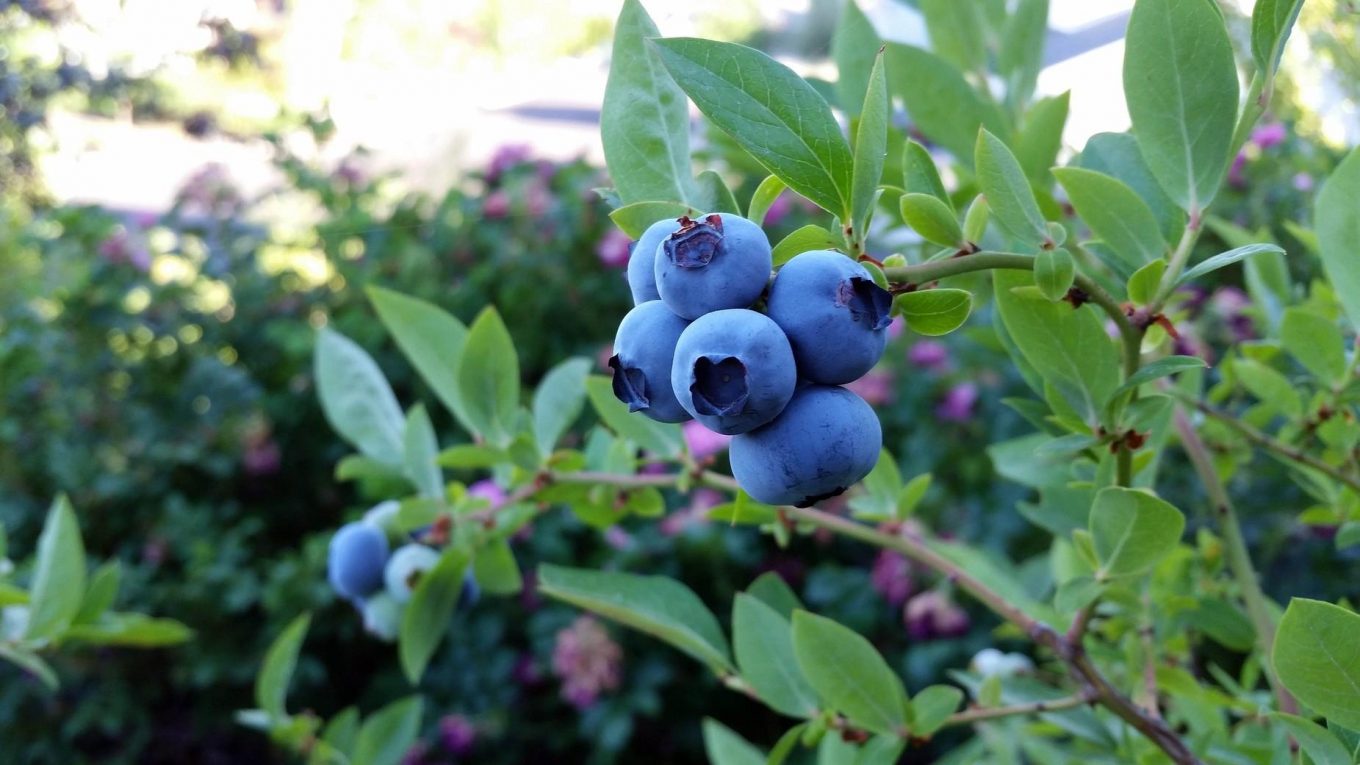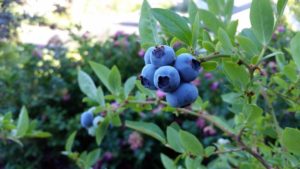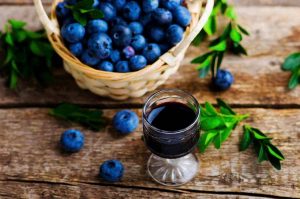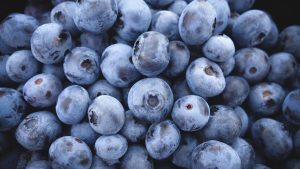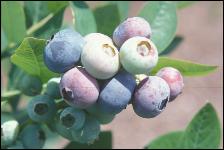Growing Blueberries in a Home Garden
It is recommended to select a combination of cultivars that can provide a continuous harvest from July through mid-September. Blueberries are self-fertile but produce more and larger berries when two or more cultivars are planted. Be sure bloom times overlap. Purchase 2- to 3-year-old plants.
Northern highbush (listed in order of ripening)
CultivarNotesBluettaShort, compact bushes with medium vigor. Medium size, crack-resistant fruit with good flavor.BluejayVery vigorous bushes with mummy berry disease resistance. Large, firm, slightly tart berries. Fruit does not drop or crack.BluerayVery productive and vigorous variety that performs well in hot climates. Large, high-quality berries.BluecropLeading variety; hardy and consistent with vigorous, upright canes. The fruit is large, firm, and crack-resistant.CovilleLarge, crack-resistant fruit holds well on canes. Very productive and upright canes.Late BlueSmall, firm, flavorful fruit borne on erect, vigorous canesElliottVery late and ornamental bush with red wood. Small to medium-size fruit does not crack or drop.Southern highbush
CultivarNotesOzarkblueVigorous, upright plant with large firm fruit.ReveilleUpright 6 ft.-7 ft. bush with medium-size firm berries.O’NealEarly, low-chill cultivar with large heat-tolerant fruit fruitCape FearLow chill, heat-tolerant cultivar that ripens mid-season.
Planting blueberries
| Blueberry note | Min. distance between rows (ft.) |
Between plants (ft.) |
Annual yield per plant (lbs.) |
Yrs. from planting to the first crop |
Av. life span (years) |
|---|---|---|---|---|---|
| Plant more than 1 variety for highest yield | 6 | 5 | 6-8 | 3-4 | 20-30 |
When to plant blueberries in Maryland
Plant blueberries as soon as the soil can be worked in the spring or one month before the first fall frost (mid-to-late September).
If plants are purchased in containers: Make the planting hole 2-3 times the rootball width so the roots can be spread out.
If bare-root plants are purchased by mail: When your order arrives, unpack the bundles and inspect the plants. The roots should be moist and have a bright, fresh appearance. Shriveled roots indicate that the plants have been allowed to freeze or dry out in storage or transit. Such plants seldom survive. Plant roots must be kept moist and free from freezing temperatures at all times.
Set plants at the same depth as they were planted in the nursery. Keep young plants well-watered. Blueberries, in particular, will not tolerate water stress.
Where to plant blueberries
Blueberries generally prefer full sun but can tolerate some shade. With Maryland’s climate becoming warmer, some light afternoon shade may prove beneficial. Try to avoid windy, dry sites. Healthy, mature blueberry plants will generally tolerate very cold temperatures, although there is some cultivar variation. Winter injury is more likely to occur when a period of mild winter weather is followed by severe cold. Most varieties require 500-750 hours of chilling below 45°F. In Maryland, this requirement is usually met no later than early February. After the chilling requirement is met, the plant loses its dormancy and, thus, its cold hardiness, making it increasingly susceptible to cold injury.
Preparing the soil for blueberries
- Blueberries are in the heath family and thrive in acidic soils (pH 4.3 – 5.3) high in organic matter. The year before planting, you should increase soil organic matter by incorporating manure or cover crops, then test and amend your soil pH according to soil lab recommendations. It’s likely that the soil pH will be greater than 5.5, requiring the addition of sulfur.
- It takes some time for sulfur to lower the soil pH, so these materials should be added in the fall before planting. Sulfur does not move through the soil readily, so surface sulfur applications after the plants are in place are not very effective in lowering the pH. Sulfur should be incorporated into the soil 6-8 inches deep.
- Special bacteria in the soil transform the added sulfur, releasing hydrogen ions that lower the soil pH. These bacteria are most effective at soil pH levels below 6.0. Therefore, it is important to add both sulfur AND iron sulfate when soil pH is above 6.0. Sulfur alone is sufficient if soil pH is below 6.0. Please refer to the table below.
- A soil pH that is too low can result in manganese or aluminum toxicity. Never attempt to lower pH with aluminum sulfate. As the pH decreases, aluminum becomes more available and may be taken up by plant roots at toxic levels. High pH results in the unavailability of certain nutrients, like iron, which results in chlorosis of the leaves (yellowing or bleaching of leaves between leaf veins).
- At planting time, amend the entire planting site, not the individual planting holes, with compost or compost and peat moss, to improve water-holding capacity. The final growing medium should be 1/3 or more organic matter (by volume) at planting time. In many cases, well-maintained blueberry plants grow and produce well when grown in high organic matter soils with soil pH >5.3.
Lowering soil pH for blueberries
Approximate pounds of sulfur or iron sulfate needed per 100 sq. ft. of soil to reduce the soil pH to 4.5 for blueberries. It is not necessary to use iron sulfate if soil pH is below 6.0. Sulfur alone will suffice to lower the pH.
| Soil Test pH |
Sandy Soil Sulfur (flowers of sulfur or elemental sulfur) |
Sandy Soil Iron Sulfate |
Loam or Clay Soil Sulfur (flowers of sulfur or elemental sulfur) |
Loam or Clay Soil Iron Sulfate |
|---|---|---|---|---|
| 7.5 | 1.2 | 4.2 | 3.5 | 12.2 |
| 7.0 | 1.0 | 3.5 | 2.9 | 10.0 |
| 6.5 | .75 | 2.6 | 2.3 | 8.0 |
| 6.0 | 1.2 | not needed | 3.5 | not needed |
| 5.5 | .8 | not needed | 2.4 | not needed |
| 5.0 | .4 | not needed | 1.2 | not needed |

